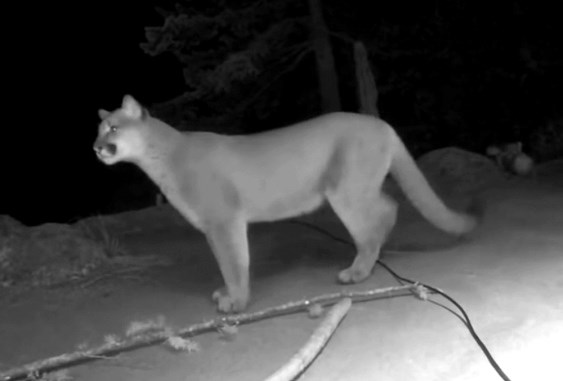Conservation officials are urging Deep Cove residents to call them immediately if they see a cougar. There were at least seven reported cougar sightings in December and January, and officials are reminding the public how to behave in the event of an interaction.
One sleek cat made local news after a Deep Cove man shared a video recording of the cougar nonchalantly wandering in his backyard. Christine Miller, education coordinator of the North Shore Brown Bear Society, said it is impossible to say whether the multiple sightings involve a single animal or more than one.
Her organization fields calls about cougars, but directs them to the Conservation Office at 1-877-952-7277. Miller speculates that recent snow falls have pushed deer and other wildlife further down the mountains and that the cougars are following their prey.
Cougars, the largest wildcats in Canada, live throughout British Columbia but generally avoid people, said David Karn, a spokesperson for the environment ministry. “Generally people aren’t even aware that they are there,” he said. “The cougar runs off and goes somewhere else.”
The reported cougar sightings, mostly in the Indian River Drive and Woodlands area, suggest some abnormal behaviour, Sgt. Todd Hunter, a conservation officer, said in a statement released to the Deep Cove Crier.
“There is some information to suggest that there is some abnormal behaviour and we’re monitoring it very closely,” he said, adding that timely reporting of sightings is critical. “The information that we have been getting has been quite a bit late and so it is difficult to be able to apply the appropriate management decisions here with respect to the cougar. We’re being very vigilant in how and when we’re going to react.”
Hunter urges people to make their properties less attractive, with domestic animals such as dogs and cats not left unattended outdoors and pet foods kept inside. Anything that can attract rodents or raccoons can also attract cougars, in part because those smaller animals can be prey for the big cats.
“If you’re going to hike with the dog, make sure it’s leashed,” Hunter said. “Hiking and biking in that area, make sure you’re with a partner. If you do confront a cougar on the trail, make sure you stop. Make sure you look big. If it doesn’t run away and it doesn’t look alarmed and scared of you, look big. Shout at the cougar.”
The Ministry of the Environment’s guidelines for cougar interactions urge calm, tell parents to pick up children, and keep an eye on the cougar while backing away slowly.
Ensure the animal has a clear avenue of escape. Keep the cougar in front of you at all times, never turning your back to a cougar or running, as sudden motion can trigger an attack. If a cougar follows, respond aggressively, maintaining eye contact, showing teeth and making loud noises. Arm yourself with rocks or sticks, without crouching more than necessary to collect them.
In the unlikely event that the cougar attacks, the guidelines urge people to fight back to convince the animal that you are a threat and not prey, targeting the animal’s face and eyes in particular.



